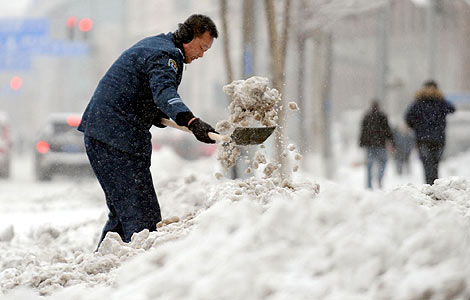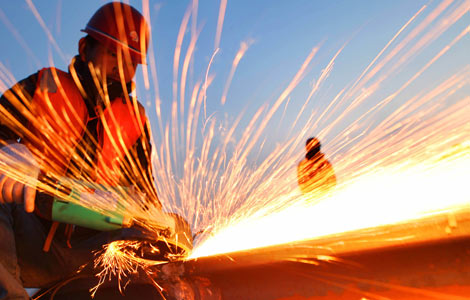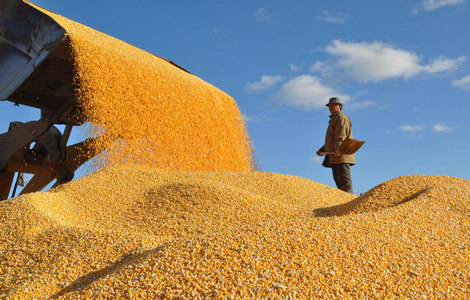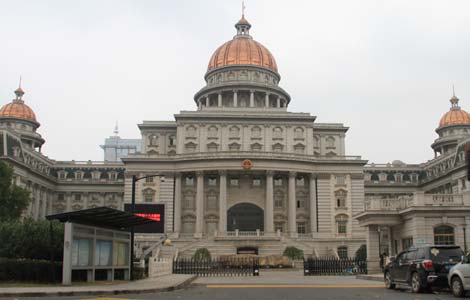
|
The Harbin-Dalian High-speed Railway under construction in Shenyang, capital of Liaoning province. China's generous investment in infrastructure and housing nurtured the nation's cement industry, which now has 3,800 producers and more than 2.9 billion tons of production capacity annually. Provided to China Daily |
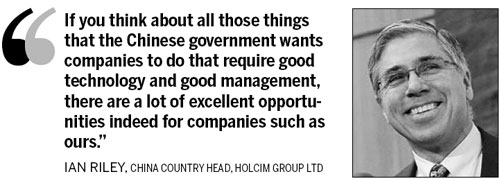
100-year-old company sees greener future for building materials industry in the nation
Nearly all the companies that our grandparents admired have disappeared because of the fast pace of change in today's world.
"For a company that lives 100 years, it has to evolve through time," said Ian Riley, China country head of Switzerland-based Holcim Group, one of the world's largest cement producers and the archrival of France's Lafarge SA.
Riley shared the simple secret at Holcim's centennial celebration in Beijing recently. He is ready to develop the company's China business into something more environmentally friendly. His plan is to turn garbage into an alternative fuel, replacing coal to produce cement.
"The vision we have in the future is that we can clean up the environment while at the same time produce reliable building materials," said the 54-year-old British senior executive.
More than 100 years ago, Holcim opened its first plant in a small village in Switzerland called Holderbank, producing 90,000 tons of cement in its first year of operation.
Today, the company's annual cement production capacity has reached 216 million tons with 149 plants plus 492 aggregates factories and 1,435 ready-mix concrete production centers in 80 countries.
"The longevity and the success of the company is not necessarily a secret. It is 100 years of very hard work and commitment and evolution to understand what the needs of today's society may be," said Riley.
For Riley, who has been involved with the China business since 1994 and moved to the country in 1998, China's needs for the sustainable development of its cement industry are pretty clear.
The National Development and Reform Commission, China's top economic planning agency, has already demanded a better environmental performance by the heavy industry that uses not only a massive amount of energy and resources for production but also emits a huge volume of greenhouse gases, such as carbon dioxide.
Most importantly, the Chinese government sees the cement industry as a potentially large contributor to solving problems in municipal waste, which can be turned into alternative fuels. The technology can also help reduce CO2 emissions.
CO2 emissions from China's cement industry account for about one-eighth of the country's industrial output of carbon dioxide, according to a recent paper by Chris Nielsen, executive director of the China Project with Harvard School of Engineering and Applied Science.
According to the 12th Five-Year Development Plan of China's Cement Industry (2011-15), the country, which currently has hardly any co-processing production lines that burn waste in the making of cement, will see around 10 percent of its cement production lines equipped with this technology by 2015.
"If you think about all those things that the Chinese government wants companies to do that require good technology and good management, there are a lot of excellent opportunities indeed for companies such as ours," Riley said.
As early as the late 1990s, the company and nine other big cement makers co-founded the world's first ever green initiative for the cement industry.
The Geneva-based Cement Sustainability Initiative, which develops guidelines for implementing greater efficiency measures through cooperation and sharing expertise among members, has since been regarded as the global pioneer for the sustainable development of the cement industry.
Apart from Holcim's well-established advantages in green cement production, the company's belief in the cement market potential in China is another driving force for Holcim's evolution in the country.
China's robust economic growth over the past several years has nurtured the world's largest cement industry because of its generous investment in infrastructure and housing, the biggest users of the product.
Concrete, which is made from cement, aggregates and water, is the second-most consumed material in the world after water, according to the Cement Sustainability Initiative.
Cement demand in China has grown by double digits each year over the past decade, in line with the economy's annual average growth rate of 10.7 percent, according to the China Cement Association.
China has the world's largest cement industry with 3,800 cement producers and more than 2.9 billion tons of cement production capacity, which accounts for more than half of the world's total.
However, a slowdown in China's economy, which is predicted to grow at an average annual rate of 7.5 percent between 2011 and 2015, is likely to result in shrinking investment in housing and infrastructure, thus oversupply of cement is getting more and more serious.
"With the rebalancing of the economy, it is crystal clear that the golden era for the cement industry is gone. But the tough times will reshape it into a more sustainable and quality-focused industry in China," said Lei Qianzhi, president of China Cement Association.
The number of cement producers in China has decreased to 3,800 over the past two to three years due to mergers and acquisitions. The top 10 cement makers in China have a 25 percent lock on production capacity in the nation, up from 15 percent in 2005. The top makers are expected to have a 35 percent market share by 2015, the 12th Five-Year Plan said.
Thanks to mergers and acquisitions, China National Building Materials Group Corp, with businesses in cement and other construction materials, was ranked 485th in the Fortune 500 list in 2011. It became the first Chinese building materials company to appear on the list. The company consolidated 154 small and medium-sized companies in eastern China over the past three years into its South Cement Co Ltd based in Shanghai. The conglomerate produced 138 million tons of cement last year.
CNBM Vice-President Cui Xingtai said in March that the group aims to increase its cement production capacity from 300 million tons a year to 500 million by 2015.
In the newly released list of the Global Fortune 500 in 2012, CNBM climbed to 365th place with $30.02 billion in revenue in 2011. Holcim was placed 474th with $23.38 billion and Lafarge was 480th with $22.97 billion.
"Through M&As, major players are able to control larger markets. By getting rid of outdated capacity and smartly reducing the actual production volume, cement can be sold at a better price. Price wars will not be as frequent," said Sun Tieshi, vice-president of China Building Material Federation.
But not every company in this capital-intensive industry is able to purchase hundreds of cement factories to increase their competitiveness. Western players in the nation's cement industry are focusing on sustainable development in the construction industry to get ahead.
Sang Kang, CEO of Lafarge Shui On Cement, a joint venture between Lafarge and Hong Kong-based Socam Development Ltd, told China Daily that the company will look to accelerate its development in sustainable construction in China. Faced with overcapacity, he said, companies that can upgrade their production models can better survive a downturn.
He views China as one of its key markets. The nation contributed 6 percent of Lafarge's global revenue in 2011, up from 2.4 percent in 2006.
Lafarge opened its first overseas sustainable construction development laboratory in Chongqing last September to develop new and advanced construction materials, products and solutions for its customers in China.
The company is currently producing dust-free cement, and a product line of concretes that it claims provides more strength and durability.
China is one of Holcim's top markets in the world, contributing more than 20 billion Swiss francs ($21.69 billion) in 2011. Senior executives from the company reckon cement demand in China has already reached its peak.
"The current market is flat. As the market continues to flatten, the nature of competition will change. The values of sustainability and environmental performance will play a much bigger role for a company's further development," said Ian Thackwray, Holcim's president for Asia-Pacific and South Africa.
The company entered China in 1995 and formed a strategic partnership with Hubei-based Huaxin Cement Co Ltd, which is one of China's oldest cement companies with a history of more than 100 years.
By investing in Huaxin, Holcim became the Chinese company's largest shareholder with 39 percent of its total shares in 2008.
The partnership has helped Huaxin Cement to achieve a steady annual growth of 30 percent in revenue over the past eight years. It had a capacity of 60 million tons last year, ranking the company in the top 10 among Chinese cement enterprises.
Holcim is clearly confident in its Chinese partner and its strategy in China. Despite a rather sluggish market with an acute oversupply in cement production capacity, Holcim reinvested in Huaxin in December to raise its shares to 42 percent of the total.
"We've already seen the slowing down of the Chinese economy is affecting the construction business. So maintaining 30 percent growth in sales this year is difficult but may be achievable," said Riley, who joined Holcim in 2006 and works as the vice-president of Huaxin Cement in Wuhan, the capital of Hubei province.
"The top priority is to continue to support Huaxin's growth, particularly to support the direction Huaxin is taking to become an environmentally friendly business," he said, adding there are a lot of opportunities in co-processing. It can pre-treat waste to use it as fuel to replace coal, gas or oil for the production of cement.
Riley said the cost of adding a co-processing facility to cement production and building a garbage pretreatment platform is about one third of the cost of constructing a waste incinerator.
He believes that using co-processing in the cement industry is a better solution than building incinerators to tackle China's garbage problems, especially for the treatment of municipal waste.
China overtook the United States in garbage output in 2004. The amount of waste has been rising at a rate of 8 to 10 percent a year. The slow process in sorting and recycling garbage and the scarcity of available space for landfill sites have made incineration a more preferable option in China.
Environmentalists in China, however, are opposed to incineration. They argue that hazardous emissions, such as the toxic dioxin, are unavoidable if the burning temperature is less than 950 C. Dioxins have been known to damage people's health. People who live near incinerators are especially vulnerable.
"The temperature used to produce cement can be as high as 1,700 C, which is much higher than the regulated temperature within an incinerator. Co-processing is a much safer way to treat waste," Riley said.
Out of the nearly 40 cement plants Huaxin has, six have already become co-processing plants. "There will be around 10 to 12 co-processing plants by this time next year," said Riley.
mengjing@chinadaily.com.cn
|
An idle cement factory in Huaibei, Anhui province. Economic slowdown in China resulted in shrinking investment in housing and infrastructure as well as an oversupply of cement. Wu He / For China Daily |
(China Daily 08/23/2012 page16)




